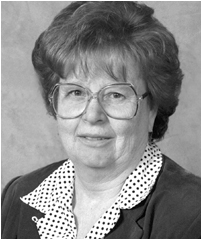 |
Dr. Glusker's love of chemistry sprang from the influence
from an excellent chemistry teacher as well as that of her parents,
both of whom were medical doctors. She
read everything she could lay her hands on about the history of
chemistry and the experiments that she could conduct using her
chemistry set. So
when it came time to go to college she chose to study chemistry
at Oxford (mainly because it gave degrees to women well before
Cambridge did). Dorothy Hodgkin interviewed Glusker for
admittance to Somerville College which is also where Glusker
spent the next six years, four as an undergraduate
with Hodgkin as her tutor, and two doing graduate work on a derivative
of vitamin B12. Thus began a long-lasting friendship,
one that Glusker valued as providing an example for women in science. Glusker
has been involved in studies of chemical carcinogens and enzyme
at Fox Chase Cancer Center in Philadelphia where she received
visits from Hodgkin on several occasions. The
techniques that Glusker uses, X-ray diffraction of crystalline
specimens, are those that Hodgkin contributed so much to.
Dorothy Hodgkin: The Quest to View
the Molecules of Life
Dorothy Hodgkin was
an exceptional scientist, with a
keen sense of observation and a
determination to develop ways to
establish the three-dimensional
structures of large, biologically
relevant molecules. She was
the first to obtain diffraction
patterns of a protein (pepsin in
1934) and so knew that its three-dimensional
structure could eventually be determined,
as she showed with her studies of
insulin, also started in 1934 and
finally established in 1969. She
played an important role in trying
out new structure-determining methods,
assessing how well they worked,
and was always conscious of possible
errors in measurement and interpretation. She
established the chemical formulae
of cholesterol (1937), penicillin
(1945), vitamin B12 (1954) and insulin
(1969) and was awarded a Nobel Prize
in 1964. A delightful
lady, plagued with crippling arthritis,
she balanced a high-powered career
with raising three children with
being active in her professional
organizations and those that champion
individual rights. She served
as Chairman of the International
Union of Crystallography and was
Chancellor of Bristol University. She
and her husband, Thomas, had a great
interest and delight in people and
their home was a haven for students,
scientists, colleagues, revolutionaries
and refugees from all over the world.
|


